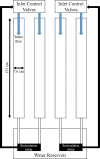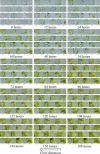Engineering of bio-mimetic substratum topographies for enhanced early colonization of filamentous algae
- PMID: 31276527
- PMCID: PMC6611581
- DOI: 10.1371/journal.pone.0219150
Engineering of bio-mimetic substratum topographies for enhanced early colonization of filamentous algae
Abstract
This work reveals a set of surface topography parameters that are significant for algal attachment to natural rock substrata. Topography analysis of rock surfaces from a stream identifies three descriptive areal parameters (Smr, Sv, and Sa) that correlate with the presence of natural periphyton community. A method was developed and validated to reverse engineer and manufacture artificial substrata with topographic complexity defined by these parameters, using computational modeling and additive manufacturing. Results from colonization experiments with filamentous algae show statistically significant increases in early biomass accrual rates on substrata with higher values of Sa and Sv parameters and lower values of Smr parameter. These results suggest that manipulation of the level of roughness (peak-to-valley distance and material ratio above the mean) and the distribution of hill and dale sequences can control initial colonization locations and biomass accrual rates, presumably by enhancing growth and recruitment of cells from the overlying flow into protected refugia spaces. As such, these findings provide an approach for optimizing the design of substratum for increased early biomass productivity for attached growth algae cultivation systems.
Conflict of interest statement
The authors have declared that no competing interests exist.
Figures







References
-
- Adey WH, Kangas PC, Mulbry W. Algal turf scrubbing: Cleaning surface waters with solar energy while producing a biofuel. Bioscience. 2011; 61: 434–441.
-
- Sandefur HN, Johnston RZ, Matlock MD, Costello TA, Adey WH, Laughinghouse Iv HD. Hydrodynamic regime considerations for the cultivation of periphytic biofilms in two tertiary wastewater treatment systems. Ecological Engineering. 2014; 71: 527–532.
-
- Mulbry W, Kangas P, Kondrad S. Toward scrubbing the bay: Nutrient removal using small algal turf scrubbers on Chesapeake Bay tributaries. Ecological Engineering. 2010; 36: 536–541.
Publication types
MeSH terms
Grants and funding
LinkOut - more resources
Full Text Sources
Research Materials

